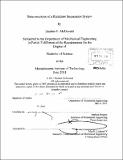Beta-prototype of a rickshaw suspension system
Author(s)
McDonald, Heather E. (Heather Elizabeth)
DownloadFull printable version (15.68Mb)
Other Contributors
Massachusetts Institute of Technology. Dept. of Mechanical Engineering.
Advisor
Barbara Hughey.
Terms of use
Metadata
Show full item recordAbstract
A suspension system was designed to make The Rickshaw Bank's bicycle-powered rickshaws more comfortable for the drivers. A four bar linkage with a rising rate spring was chosen as the design. An unconventional material-tire rubber-was used as the spring material because it is inexpensive, requires limited tooling, and is in vast supply near The Rickshaw Bank's factory in Assam, India. Different configurations of tire rubber were tested to see how the size, length, and placement of the spring affected the system's performance. Bode Plots of the system's response function were generated for each configuration. The functionality of the suspension system within the 10-20 Hz range was of premier importance because it is in this frequency range that the bicycle-powered rickshaws most often operate, based on their speed and the road conditions the rickshaw regularly encounters. Ultimately, it was demonstrated that the placement of the spring within the suspension system had the greatest effect on the system's response. The configuration that applied the greatest moment to the top link of the four bar linkage performed best. Surprisingly, any advantages arising from varying the geometry of the tire rubber pieces were lost to friction and the effect of the ply embedded in the tire rubber. In order to properly verify the optimal spring placement and tire rubber spring geometry, a suspension system that takes this paper's findings into account should be tested with a rickshaw in India.
Description
Thesis (S.B.)--Massachusetts Institute of Technology, Dept. of Mechanical Engineering, 2011. Cataloged from PDF version of thesis. Includes bibliographical references (p. 64).
Date issued
2011Department
Massachusetts Institute of Technology. Department of Mechanical EngineeringPublisher
Massachusetts Institute of Technology
Keywords
Mechanical Engineering.